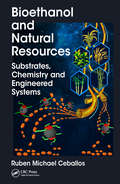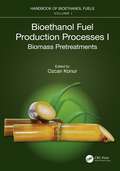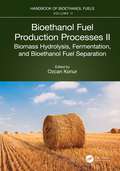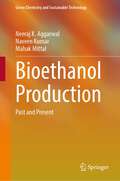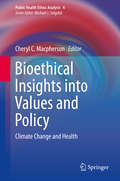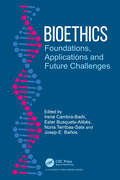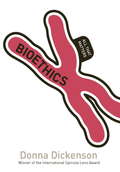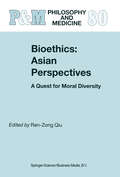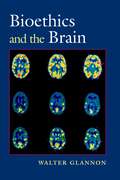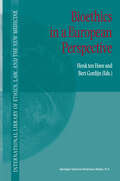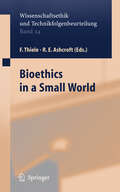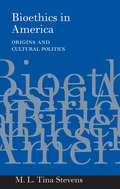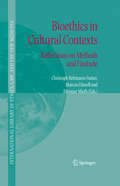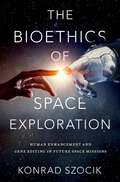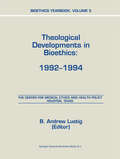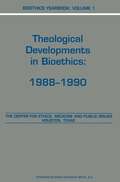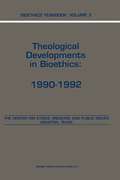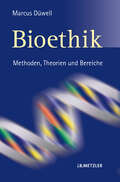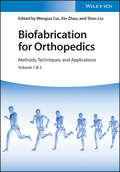- Table View
- List View
Bioethanol and Natural Resources: Substrates, Chemistry and Engineered Systems
by Ruben Michael CeballosBioethanol and Natural Resources: Substrates, Chemistry and Engineered Systems provides a comprehensive review of feedstocks, physiochemical and biological pretreatments, molecular substrates, cellulolytic and ligninolytic enzymes, and advanced technologies for producing bioethanol. Although this book provides a review of first-generation bioethanol feedstocks, chemistry, and processes, there is an emphasis on second-generation "cellulosic" ethanol production. With rapid advances in biofuels technologies and the continued global dependency on unsustainable extraction of fossil fuels, this text is timely. Although it is intended to be used as a supplemental text for advanced undergraduate or graduate level courses, the book is accessible to a non-academic audience. This book provides a unique opportunity to understand bioethanol production from the basic concepts and processes to the most cutting-edge technologies under development.
Bioethanol Fuel Production Processes. I: Biomass Pretreatments
by Ozcan KonurThis book presents research on biomass pretreatments, which are a fundamental part of bioethanol fuel production to make biomass more accessible. This book also includes an introductory section on the bioethanol fuels. Bioethanol Fuel Production Processes. I: Biomass Pretreatments is the first volume in the Handbook of Bioethanol Fuels (Six-Volume Set). The primary pretreatments at the macro level are the biological chemical, hydrothermal, and mechanical pretreatments of the biomass. It also has an introductory section on the biomass pretreatments at large for bioethanol fuel production. The major pretreatments at the micro level are the enzymatic and fungal pretreatments of the biomass as the biological pretreatments, acid, alkaline, ionic liquid, and organic solvent pretreatment pretreatments of the biomass as the chemical pretreatments, steam explosion and liquid hot water pretreatments of the biomass as the hydrothermal pretreatments, and milling, ultrasonic, and microwave pretreatments of the biomass as the mechanical pretreatments. The first volume also indicates that a wide range of pretreatments stand alone or in combination with each other fractionate the biomass to its constituents of cellulose, lignin, and hemicellulose and improve both sugar and bioethanol fuel yield, making this bioethanol fuel more competitive in relation to crude oil- and natural gas-based fossil fuels. This first volume is a valuable resource for the stakeholders primarily in the research fields of energy and fuels, chemical engineering, environmental science and engineering, biotechnology, microbiology, chemistry, physics, mechanical engineering, agricultural sciences, food science and engineering, materials science, biochemistry, genetics, molecular biology, plant sciences, water resources, economics, business, management, transportation science and technology, ecology, public, environmental and occupational health, social sciences, toxicology, multidisciplinary sciences, and humanities among others.
Bioethanol Fuel Production Processes. I: Biomass Pretreatments
This book presents research on biomass pretreatments, which are a fundamental part of bioethanol fuel production to make biomass more accessible. This book also includes an introductory section on the bioethanol fuels. Bioethanol Fuel Production Processes. I: Biomass Pretreatments is the first volume in the Handbook of Bioethanol Fuels (Six-Volume Set). The primary pretreatments at the macro level are the biological chemical, hydrothermal, and mechanical pretreatments of the biomass. It also has an introductory section on the biomass pretreatments at large for bioethanol fuel production. The major pretreatments at the micro level are the enzymatic and fungal pretreatments of the biomass as the biological pretreatments, acid, alkaline, ionic liquid, and organic solvent pretreatment pretreatments of the biomass as the chemical pretreatments, steam explosion and liquid hot water pretreatments of the biomass as the hydrothermal pretreatments, and milling, ultrasonic, and microwave pretreatments of the biomass as the mechanical pretreatments. The first volume also indicates that a wide range of pretreatments stand alone or in combination with each other fractionate the biomass to its constituents of cellulose, lignin, and hemicellulose and improve both sugar and bioethanol fuel yield, making this bioethanol fuel more competitive in relation to crude oil- and natural gas-based fossil fuels. This first volume is a valuable resource for the stakeholders primarily in the research fields of energy and fuels, chemical engineering, environmental science and engineering, biotechnology, microbiology, chemistry, physics, mechanical engineering, agricultural sciences, food science and engineering, materials science, biochemistry, genetics, molecular biology, plant sciences, water resources, economics, business, management, transportation science and technology, ecology, public, environmental and occupational health, social sciences, toxicology, multidisciplinary sciences, and humanities among others.
Bioethanol Fuel Production Processes. II: Biomass Hydrolysis, Fermentation, and Bioethanol Fuel Separation
by Ozcan KonurThis book provides an overview of the research on production processes for bioethanol fuels in general, hydrolysis of the pretreated biomass for bioethanol production, microbial fermentation of hydrolysates and substrates with yeasts for bioethanol production, and separation and distillation of bioethanol fuels from the fermentation broth, complementing the research on biomass pretreatments presented in the first volume. It presents an overview of the research on biomass hydrolysis in general, wood hydrolysis, straw hydrolysis, and cellulose hydrolysis for bioethanol fuel production in the first section for biomass hydrolysis. It provides an overview of the research on microbial hydrolysate fermentation for bioethanol production in general, alternative fermentation processes for bioethanol fuel production such as simultaneous saccharification and fermentation (SSF) and consolidated biomass processing (CBP) compared with the separate hydrolysis and fermentation (SHF) process, metabolic engineering of microorganisms and substrates for bioethanol fuel production, and utilization of Saccharomyces cerevisiae for microbial fermentation of hydrolysates for bioethanol fuel production in the second section for hydrolysate fermentation. It provides an overview of the research on the bioethanol fuel separation from the fermentation broth in the last section. This book is a valuable resource for the stakeholders primarily in the research fields of energy and fuels, chemical engineering, environmental science and engineering, biotechnology, microbiology, chemistry, physics, mechanical engineering, agricultural sciences, food science and engineering, materials science, biochemistry, genetics, molecular biology, plant sciences, water resources, economics, business, management, transportations science and technology, ecology, public, environmental and occupational health, social sciences, toxicology, multidisciplinary sciences, and humanities among others.
Bioethanol Fuel Production Processes. II: Biomass Hydrolysis, Fermentation, and Bioethanol Fuel Separation
This book provides an overview of the research on production processes for bioethanol fuels in general, hydrolysis of the pretreated biomass for bioethanol production, microbial fermentation of hydrolysates and substrates with yeasts for bioethanol production, and separation and distillation of bioethanol fuels from the fermentation broth, complementing the research on biomass pretreatments presented in the first volume. It presents an overview of the research on biomass hydrolysis in general, wood hydrolysis, straw hydrolysis, and cellulose hydrolysis for bioethanol fuel production in the first section for biomass hydrolysis. It provides an overview of the research on microbial hydrolysate fermentation for bioethanol production in general, alternative fermentation processes for bioethanol fuel production such as simultaneous saccharification and fermentation (SSF) and consolidated biomass processing (CBP) compared with the separate hydrolysis and fermentation (SHF) process, metabolic engineering of microorganisms and substrates for bioethanol fuel production, and utilization of Saccharomyces cerevisiae for microbial fermentation of hydrolysates for bioethanol fuel production in the second section for hydrolysate fermentation. It provides an overview of the research on the bioethanol fuel separation from the fermentation broth in the last section. This book is a valuable resource for the stakeholders primarily in the research fields of energy and fuels, chemical engineering, environmental science and engineering, biotechnology, microbiology, chemistry, physics, mechanical engineering, agricultural sciences, food science and engineering, materials science, biochemistry, genetics, molecular biology, plant sciences, water resources, economics, business, management, transportations science and technology, ecology, public, environmental and occupational health, social sciences, toxicology, multidisciplinary sciences, and humanities among others.
Bioethanol: A Green Energy Substitute for Fossil Fuels (Green Energy and Technology)
by Eriola Betiku Mofoluwake M. IsholaThis book looks deeply into the prospects for using ethanol as a greener alternative to fossil fuels and the technical and scientific issues that surround them. Ethanol, with its numerous advantages, has emerged as a promising contender to replace gasoline as a fuel source. Currently, it is commercially available as a blend with gasoline, commonly known as E10 and E25, utilizing various ratios of ethanol. Despite its clear benefits over gasoline, the widespread adoption of ethanol as a fuel remains hindered by its limited availability. In this insightful book, we aim to explore the multifaceted challenges surrounding ethanol's full integration into our energy landscape, employing a comprehensive approach through review manuscripts. Leading worldwide experts, known for their deep understanding of ethanol as a fuel, have contributed to the book. Their valuable insights and contributions enrich the book's content, offering readers a comprehensive exploration of the subject matter. This book is a compelling resource for researchers, energy professionals, and anyone interested in understanding the challenges and opportunities associated with the integration of ethanol as a substitute for gasoline.
Bioethanol Production: Past and Present (Green Chemistry and Sustainable Technology)
by Neeraj K. Aggarwal Naveen Kumar Mahak MittalThis book provides the latest research on bioethanol production from first- and second- generation feedstock. Bioethanol has emerged as one of the main alternative biofuels in recent years. The book provides a perspective on the chemistry, sources and production of bioethanol highlighting the recent developments in the field.Through this book readers will learn basic and advanced bioethanol production technologies under one roof, including resource management and environmental and economic impacts. The topics discussed in the book will attract researchers and scholars focusing in this field as well as anyone who is interested in green and sustainable energy resources.
Bioethical Insights into Values and Policy: Climate Change and Health (Public Health Ethics Analysis #4)
by Cheryl C. MacphersonChanges in earth’s atmosphere, oceans, soil, weather patterns, and ecosystems are well documented by countless scientific disciplines. These manifestations of climate change harm public health. Given their goals and social responsibilities, influential health organizations recognize health impacts compounded by geography, social values, social determinants of health, health behaviors, and relationships between humans and environments primarily described in feminist ethics and environmental ethics. Health impacts are relevant to, but seldom addressed in bioethics, global health, public policy, or health or environmental policy. This book is the first to describe cultural, geographic, and socioeconomic factors that influence the regional significance of these impacts and frame them for bioethics and policy analyses.
Bioethics: Foundations, Applications and Future Challenges
by Irene Cambra-Badii Ester Busquets-Alibés Terribas-Sala Núria Josep-E. BañosThe aim of this book is to introduce and discuss bioethics in a three-synergistic way: from the foundations to the current debates in relation to healthcare and social bioethics, and thereafter the possible future challenges. In this sense, the target audience can be from diverse disciplines: life and medical sciences, law, philosophy, psychology, and education. The book will be useful to high school students, in their first contacts with bioethics, college students, teachers and researchers, and the general public interested in these controversial debates of the past, present and future of bioethics.
Bioethics: All That Matters Enhanced Apple (All That Matters #39)
by Donna DickensonIn this book:Donna Dickenson - Winner of the International Spinoza Lens AwardShould we do what ever science lets us do?Bioethics: All That Matters, new developments in biotechnology like genetics, stem cell research and artificial reproduction arouse both our greatest hopes and our greatest fears. Many people invest the new biotechnology with all the aspirations and faith once accorded to religious salvation. But does everyone benefit equally from scientific progress? Commercialised modern biomedicine runs the risk of exploiting vulnerable groups, from Indian 'surrogate' mothers to professional guinea pigs in drug research. Professor Dickenson argues that although we've entered new scientific territory, there's no need to jettison our existing moral sense. By discussing a range of real-life cases, she equips readers to make up their own minds on these important and controversial questions. Good science and good ethics needn't be contradictory.This accessible and concise book will appeal to both students and general readers, giving a fascinating introduction to a wide range of perspectives on Bioethics.All That Matters books:All books in the All That Matters series are written by world experts in their subject field. These experts work to distil a topic and get right to its heart, making the book accessible for both students and general readers. Each compelling book contains new and interesting perspectives and tells stories that matter.The Author:All That Matters - Interesting introductions to important issuesBooks on the following subjects are available from the All That Matters series: Muhammad, God, Water, Political Philosophy, Sustainability, Philosophy, Intelligence, Love, Russian Revolution, War, and Creativity.To find out more visit: www.allthatmattersbooks.com
Bioethics: A Quest for Moral Diversity (Philosophy and Medicine #80)
by Ren-Zong QiuThis is the first volume on bioethics all contributors of which are exclusively non-western scholars. The book unfolds a rich and colorful picture and addresses thorny bioethical issues from comprehensive Asian perspectives and different from the western paradigm of bioethics. It is of interest to senior undergraduate and graduate students, philosophers, physicians, scholars of Asian and culture studies, geneticists, sinologists, medical anthropologists, health administrators, and health officials.
Bioethics: Foundations, Applications and Future Challenges
The aim of this book is to introduce and discuss bioethics in a three-synergistic way: from the foundations to the current debates in relation to healthcare and social bioethics, and thereafter the possible future challenges. In this sense, the target audience can be from diverse disciplines: life and medical sciences, law, philosophy, psychology, and education. The book will be useful to high school students, in their first contacts with bioethics, college students, teachers and researchers, and the general public interested in these controversial debates of the past, present and future of bioethics.
Bioethics in a European Perspective (International Library of Ethics, Law, and the New Medicine #8)
by H. A. Ten Have Bert GordijnThis book gives an overview of the most salient themes in present-day bioethics. The book focuses on perspectives typical for the European context. This highlights not only particular bioethical themes such as social justice, choices in health care, and health policy (e.g., in post-communist countries), it also emphasizes specific approaches in ethical theory, in relation to Continental philosophies such as phenomenology and hermeneutics.
Bioethics in America: Origins and Cultural Politics
by M. L. StevensIn Bioethics in America, Tina Stevens challenges the view that the origins of the bioethics movement can be found in the 1960s, a decade mounting challenges to all variety of authority. Instead, Stevens sees bioethics as one more product of a "centuries-long cultural legacy of American ambivalence toward progress," and she finds its modern roots in the responsible science movement that emerged following detonation of the atomic bomb.Rather than challenging authority, she says, the bioethics movement was an aid to authority, in that it allowed medical doctors and researchers to proceed on course while bioethicists managed public fears about medicine's new technologies. That is, the public was reassured by bioethical oversight of biomedicine; in reality, however, bioethicists belonged to the same mainstream that produced the doctors and researchers whom the bioethicists were guiding.
Bioethics in Cultural Contexts: Reflections on Methods and Finitude (International Library of Ethics, Law, and the New Medicine #28)
by Christoph Rehmann-Sutter Marcus Düwell Dietmar MiethCHRISTOPH REHMANN-SUTTER, MARCUS DÜWELL, DIETMAR MIETH When we placed “finitude”, “limits of human existence” as a motto over a round of discussion on biomedicine and bioethics (which led to this collection of essays) we did not know how far this would lead us into methodological quandaries. However, we felt intuitively that an interdisciplinary approach including social and cultural sciences would have an advantage over a solely disciplinary (philosophical or theological) analysis. Bioethics, if it is to have adequate discriminatory power, should include sensitivity to the cultural contexts of biomedicine, and also to the cultural contexts of bioethics itself. Context awareness, of course, is not foreign to philosophical or theological bioethics, for the simple reason that the issues tackled in the debates (as in other fields of ethics) could not be adequately understood outside their contexts. Moral issues are always accompanied by contexts. When we try to unpack them – which is necessary to make them accessible to ethical discussion – we are regularly confronted with the fact that in removing too much of the context we do not clarify an issue, but make it less comprehensible. The context – at least some essential parts of it – is intrinsic to the issue. Unpacking in ethics is therefore a different procedure. It does not mean peeling the context off, but rather identifying which contextual elements are essential for an understanding of the key moral aspects of the issue, and explaining how they establish its particular character.
The Bioethics of Space Exploration
by Konrad SzocikThe first book devoted to the bioethics of the space-mission environment, The Bioethics of Space Exploration explores the ethical status of possible biomedical challenges in future long-term space missions. Konrad Szocik thoroughly examines arguments favoring and opposing human enhancement, accompanied by somatic and germline gene editing, methodology of space-mission bioethics, and moral bioenhancement. In particular, the three main types of space missions--scientific missions, commercial missions, and space colonization missions--prompt different bioethical discussions and levels of human involvement. Szocik also considers whether the possibility of saving humanity through space colonization is compatible with ethics of quality of life and the philosophy of antinatalism. Presented from an issue-driven and case-driven perspective, The Bioethics of Space Exploration highlights the utility of different normative systems for philosophers, ethicists, and social scientists alike. For any reader interested in the broader humanistic and social approach to space missions, these insightful discussions provide a new perspective into the future of space missions and the potential for radical biomedical technologies.
The Bioethics of Space Exploration
by Konrad SzocikThe first book devoted to the bioethics of the space-mission environment, The Bioethics of Space Exploration explores the ethical status of possible biomedical challenges in future long-term space missions. Konrad Szocik thoroughly examines arguments favoring and opposing human enhancement, accompanied by somatic and germline gene editing, methodology of space-mission bioethics, and moral bioenhancement. In particular, the three main types of space missions--scientific missions, commercial missions, and space colonization missions--prompt different bioethical discussions and levels of human involvement. Szocik also considers whether the possibility of saving humanity through space colonization is compatible with ethics of quality of life and the philosophy of antinatalism. Presented from an issue-driven and case-driven perspective, The Bioethics of Space Exploration highlights the utility of different normative systems for philosophers, ethicists, and social scientists alike. For any reader interested in the broader humanistic and social approach to space missions, these insightful discussions provide a new perspective into the future of space missions and the potential for radical biomedical technologies.
Bioethics Yearbook: Theological Developments in Bioethics: 1992–1994 (Bioethics Yearbook #5)
by B. AndrewLustigAs the field of bioethics has matured, increasing attention is being paid to how bioethical issues are treated in different moral and religious traditions and in different regions of the world. It is often difficult, however, to obtain timely information about these matters. The Bioethics Yearbook series analyzes how such issues as new reproductive techniques, abortion, maternal-fetal conflicts, care of seriously ill newborns, consent, confidentiality, equitable access, cost-containment, withholding and withdrawing treatment, euthanasia, the definition of death, and organ transplantation are being discussed in different religions and regions. Volume 5 discusses theological developments from 1992 to 1994 in Anglican, Baptist, Catholic, Hindu, Jehovah's Witness, Jewish, Latter-Day Saint, Lutheran, Methodist, Muslim, Pentecostal, and Presbyterian traditions.
Bioethics Yearbook: Theological Developments in Bioethics: 1988–1990 (Bioethics Yearbook #1)
by Thomas J. Bole Laurence B. McCullough H. TristramEngelhardt B. AndrewLustig Baruch A. BrodyAs the field of bioethics has matured, increasing attention is being paid to how bioethical issues are treated in different moral and religious traditions and in different parts of the world. It is often difficult, however, to get accurate information about these matters. The Bioethics Yearbook Series provides interested parties with analyses of how such issues as new reproductive techniques, abortion, maternal-fetal conflicts, care of seriously ill newborns, consent, confidentiality, equitable access, cost-containment, withdrawing treatment, active euthanasia, the definition of death, and organ transplantation are being discussed in these different traditions and different parts of the world. The first volume, and every second succeeding volume, will discuss developments in the Anglican, Baptist, Buddhist, Catholic, Eastern Orthodox, Hindu, Jewish, LDS, Lutheran, Methodist, Muslim, and Presbyterian Traditions. The second volume, and every second volume succeeding it, will discuss official governmental and medical society policies on these topics throughout the world.
Bioethics Yearbook: Theological Developments in Bioethics: 1990–1992 (Bioethics Yearbook #3)
by B. Andrew Lustig Baruch A. Brody H. Tristram Engelhardt Laurence B. McCulloughAs the field of bioethics has matured, increasing attention is being paid to how bioethical issues are treated in different moral and religious traditions and in different regions of the world. It is often difficult, however, to obtain accurate information about these matters. The Bioethics Yearbook series provides interested parties with analyses of how such issues as new reproductive techniques, abortion, maternal-fetal conflicts, care of seriously ill newborns, consent, confidentiality, equitable access, cost-containment, withholding and withdrawing treatment, active euthanasia, the definition of death, and organ transplantation are being discussed in different religious traditions and regions. Volume Three discusses theological developments from 1990--1992 in Anglican, Baptist, Buddhist, Catholic, Continental Protestant, Eastern Orthodox, Hindu, Jewish, Latter-Day Saint, Lutheran, Methodist, Muslim, and Presbyterian traditions. Volume Four will continue coverage of official governmental and medical society policies on these topics throughout the world.
Bioethik: Methoden, Theorien und Bereiche
by Marcus DüwellHeiß umstritten: Stammzell- und Embryonenforschung, Gentechnologie, Euthanasie. Was ist ethisch vertretbar? Marcus Düwell stellt die Diskussionen um die Grenzen menschlichen Handelns, um Leben und Natur und um den wissenschaftlichen Fortschritt auf ein philosophisches Fundament. Er erläutert Geschichte, Methoden und Begriffe der Bioethik und geht der Frage nach: Wie ist die veränderte Welt moralphilosophisch zu bewerten? Das Grundlagenwerk hilft bei der Orientierung.
Biofabrication for Orthopedics: Methods, Techniques and Applications
by Wenguo Cui Xin Zhao Shen LiuBiofabrication for Orthopedics A comprehensive overview of biofabrication techniques for orthopedics and their novel applications With an ever-increasing global population and the rise in the occurrence of orthopedic diseases amongst an aging population, it is essential for technological advances to meet this growing medical need. Orthopedic biofabrication is a cutting-edge field that seeks to produce novel clinical solutions to this mounting problem, through the incorporation of revolutionary technologies that have the potential to not only transform healthcare, but also provide highly automated and personalized patient solutions. With the advances in the discipline, there is a significant growing interest in biofabrication for orthopedics in research activity geared towards routine clinical use. Ideal for a broad readership amongst medical practitioners and scientists, Biofabrication for Orthopedics summarizes all aspects of the topic: detailed information on the technology, along with advanced developments, research progress, and future perspectives on biofabrication for orthopaedics—particularly on the potential applications for tissue engineering technologies. In doing so, the book describes the various biomaterials—natural and synthetic—use for orthopedics and discusses the many ways in which these materials can be used in all parts of the body. As such, it offers detailed information on a wide range of applications in the fields of biology and clinical and industrial manufacturing. Biofabrication for Orthopedics readers will also find: Insights into the applications of biofabrication technologies in various bodily functions Thorough discussion of different biofabrication techniques used in creating orthopedic products, like stereolithography, cell sheet and organ bioprinting, electrospinning, and microfluidics Discussion of a wide range of diverse functions, such as bone implants, skin regeneration, vascularization, meniscus remodeling, and more Biofabrication for Orthopedics is a useful reference for those in a variety of research fields like medical-related practitioners and scientists, materials science, medicine, and manufacturing, as well as the libraries who support them.
Biofabrication for Orthopedics: Methods, Techniques and Applications
by Wenguo Cui Xin Zhao Shen LiuBiofabrication for Orthopedics A comprehensive overview of biofabrication techniques for orthopedics and their novel applications With an ever-increasing global population and the rise in the occurrence of orthopedic diseases amongst an aging population, it is essential for technological advances to meet this growing medical need. Orthopedic biofabrication is a cutting-edge field that seeks to produce novel clinical solutions to this mounting problem, through the incorporation of revolutionary technologies that have the potential to not only transform healthcare, but also provide highly automated and personalized patient solutions. With the advances in the discipline, there is a significant growing interest in biofabrication for orthopedics in research activity geared towards routine clinical use. Ideal for a broad readership amongst medical practitioners and scientists, Biofabrication for Orthopedics summarizes all aspects of the topic: detailed information on the technology, along with advanced developments, research progress, and future perspectives on biofabrication for orthopaedics—particularly on the potential applications for tissue engineering technologies. In doing so, the book describes the various biomaterials—natural and synthetic—use for orthopedics and discusses the many ways in which these materials can be used in all parts of the body. As such, it offers detailed information on a wide range of applications in the fields of biology and clinical and industrial manufacturing. Biofabrication for Orthopedics readers will also find: Insights into the applications of biofabrication technologies in various bodily functions Thorough discussion of different biofabrication techniques used in creating orthopedic products, like stereolithography, cell sheet and organ bioprinting, electrospinning, and microfluidics Discussion of a wide range of diverse functions, such as bone implants, skin regeneration, vascularization, meniscus remodeling, and more Biofabrication for Orthopedics is a useful reference for those in a variety of research fields like medical-related practitioners and scientists, materials science, medicine, and manufacturing, as well as the libraries who support them.
